seats TESLA MODEL S 2014 Owner's manual (Europe)
[x] Cancel search | Manufacturer: TESLA, Model Year: 2014, Model line: MODEL S, Model: TESLA MODEL S 2014Pages: 152, PDF Size: 17.5 MB
Page 3 of 152
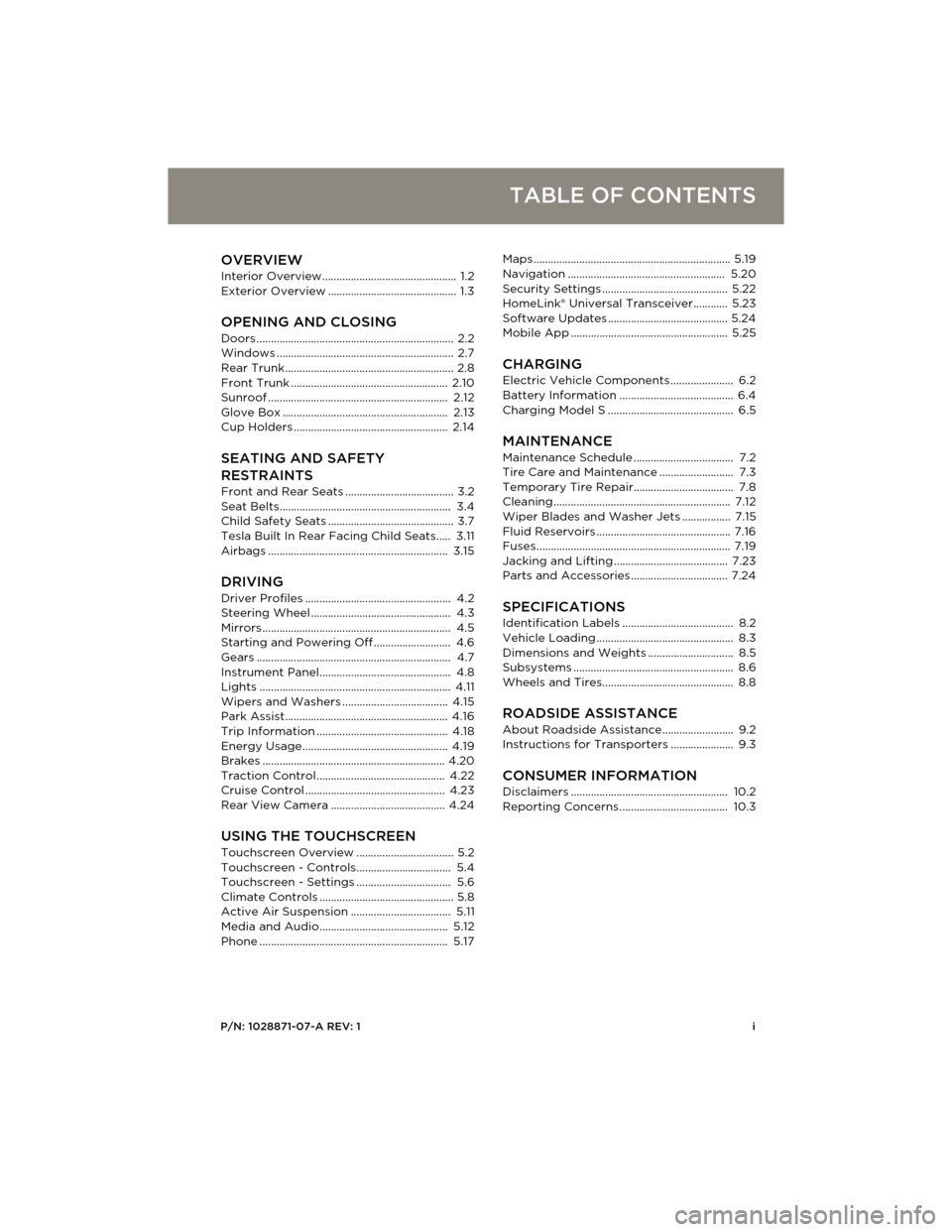
P/N: 1028871-07-A REV: 1i
TABLE OF CONTENTS
OVERVIEWInterior Overview............................................... 1.2
Exterior Overview ............................................. 1.3
OPENING AND CLOSING
Doors ..................................................................... 2.2
Windows .............................................................. 2.7
Rear Trunk........................................................... 2.8
Front Trunk ....................................................... 2.10
Sunroof ............................................................... 2.12
Glove Box .......................................................... 2.13
Cup Holders ...................................................... 2.14
SEATING AND SAFETY
RESTRAINTS
Front and Rear Seats ...................................... 3.2
Seat Belts............................................................ 3.4
Child Safety Seats ............................................ 3.7
Tesla Built In Rear Facing Child Seats..... 3.11
Airbags ............................................................... 3.15
DRIVINGDriver Profiles ................................................... 4.2
Steering Wheel ................................................. 4.3
Mirrors .................................................................. 4.5
Starting and Powering Off ........................... 4.6
Gears .................................................................... 4.7
Instrument Panel.............................................. 4.8
Lights ................................................................... 4.11
Wipers and Washers ..................................... 4.15
Park Assist......................................................... 4.16
Trip Information .............................................. 4.18
Energy Usage................................................... 4.19
Brakes ................................................................ 4.20
Traction Control............................................. 4.22
Cruise Control ................................................. 4.23
Rear View Camera ........................................ 4.24
USING THE TOUCHSCREEN
Touchscreen Overview.................................. 5.2
Touchscreen - Controls................................. 5.4
Touchscreen - Settings................................. 5.6
Climate Controls ............................................... 5.8
Active Air Suspension ................................... 5.11
Media and Audio............................................. 5.12
Phone .................................................................. 5.17Maps ..................................................................... 5.19
Navigation ....................................................... 5.20
Security Settings ............................................ 5.22
HomeLink® Universal Transceiver............ 5.23
Software Updates .......................................... 5.24
Mobile App ....................................................... 5.25
CHARGING
Electric Vehicle Components ...................... 6.2
Battery Information ........................................ 6.4
Charging Model S ............................................ 6.5
MAINTENANCE
Maintenance Schedule ................................... 7.2
Tire Care and Maintenance .......................... 7.3
Temporary Tire Repair................................... 7.8
Cleaning.............................................................. 7.12
Wiper Blades and Washer Jets ................. 7.15
Fluid Reservoirs ............................................... 7.16
Fuses.................................................................... 7.19
Jacking and Lifting ........................................ 7.23
Parts and Accessories .................................. 7.24
SPECIFICATIONS
Identification Labels ....................................... 8.2
Vehicle Loading ................................................ 8.3
Dimensions and Weights .............................. 8.5
Subsystems ........................................................ 8.6
Wheels and Tires.............................................. 8.8
ROADSIDE ASSISTANCE
About Roadside Assistance......................... 9.2
Instructions for Transporters ...................... 9.3
CONSUMER INFORMATIONDisclaimers ....................................................... 10.2
Reporting Concerns ...................................... 10.3
book.book Page i Friday, July 19, 2013 12:53 PM
Page 6 of 152
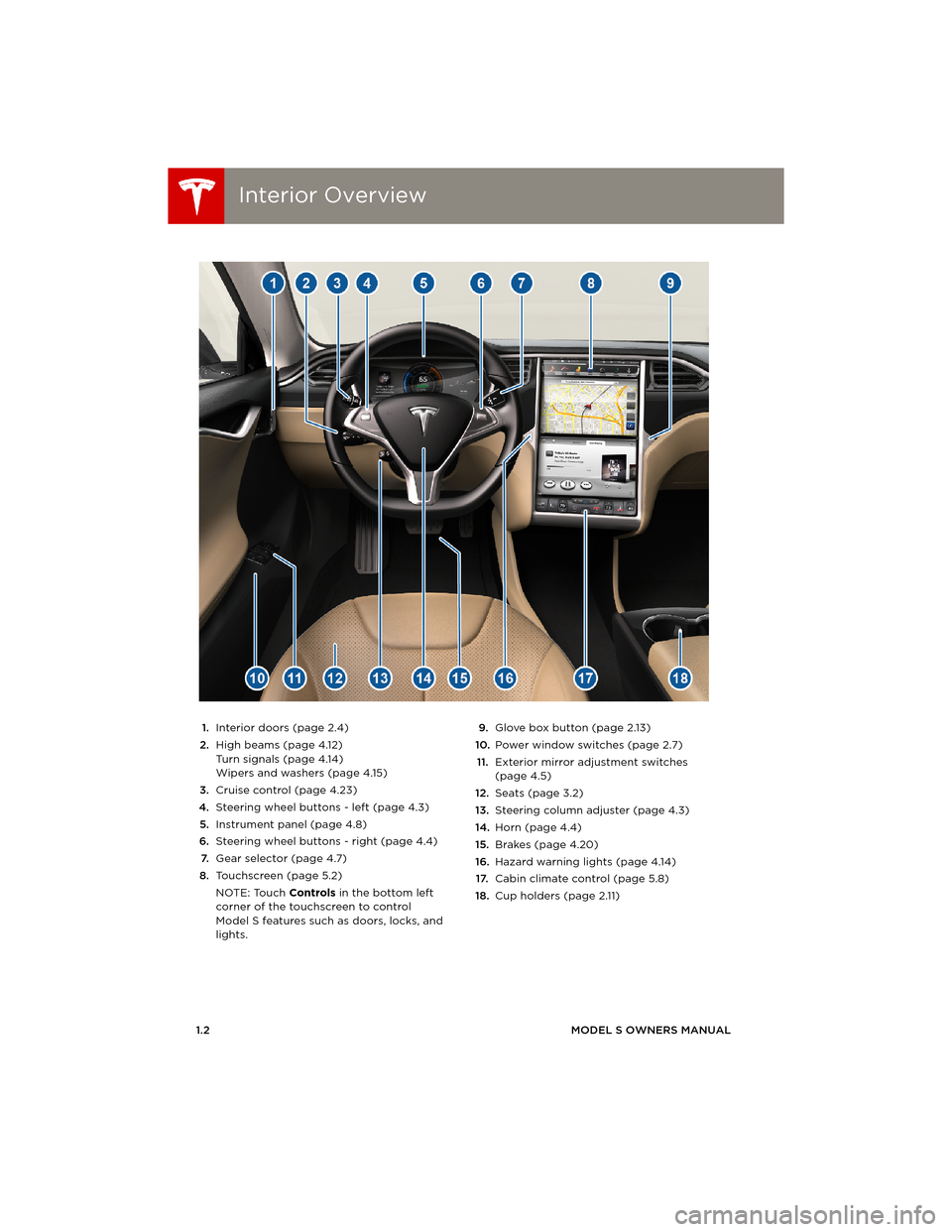
Interior OverviewInterior Overview
1.2MODEL S OWNERS MANUAL
OVERVIEW
1.Interior doors (page 2.4)
2.High beams (page 4.12)
Turn signals (page 4.14)
Wipers and washers (page 4.15)
3.Cruise control (page 4.23)
4.Steering wheel buttons - left (page 4.3)
5.Instrument panel (page 4.8)
6.Steering wheel buttons - right (page 4.4)
7.Gear selector (page 4.7)
8.Touchscreen (page 5.2)
NOTE: Touch Controls in the bottom left
corner of the touchscreen to control
Model S features such as doors, locks, and
lights.9.Glove box button (page 2.13)
10.Power window switches (page 2.7)
11.Exterior mirror adjustment switches
(page 4.5)
12.Seats (page 3.2)
13.Steering column adjuster (page 4.3)
14.Horn (page 4.4)
15.Brakes (page 4.20)
16.Hazard warning lights (page 4.14)
17.Cabin climate control (page 5.8)
18.Cup holders (page 2.11)
book.book Page 2 Friday, July 19, 2013 12:53 PM
Page 13 of 152
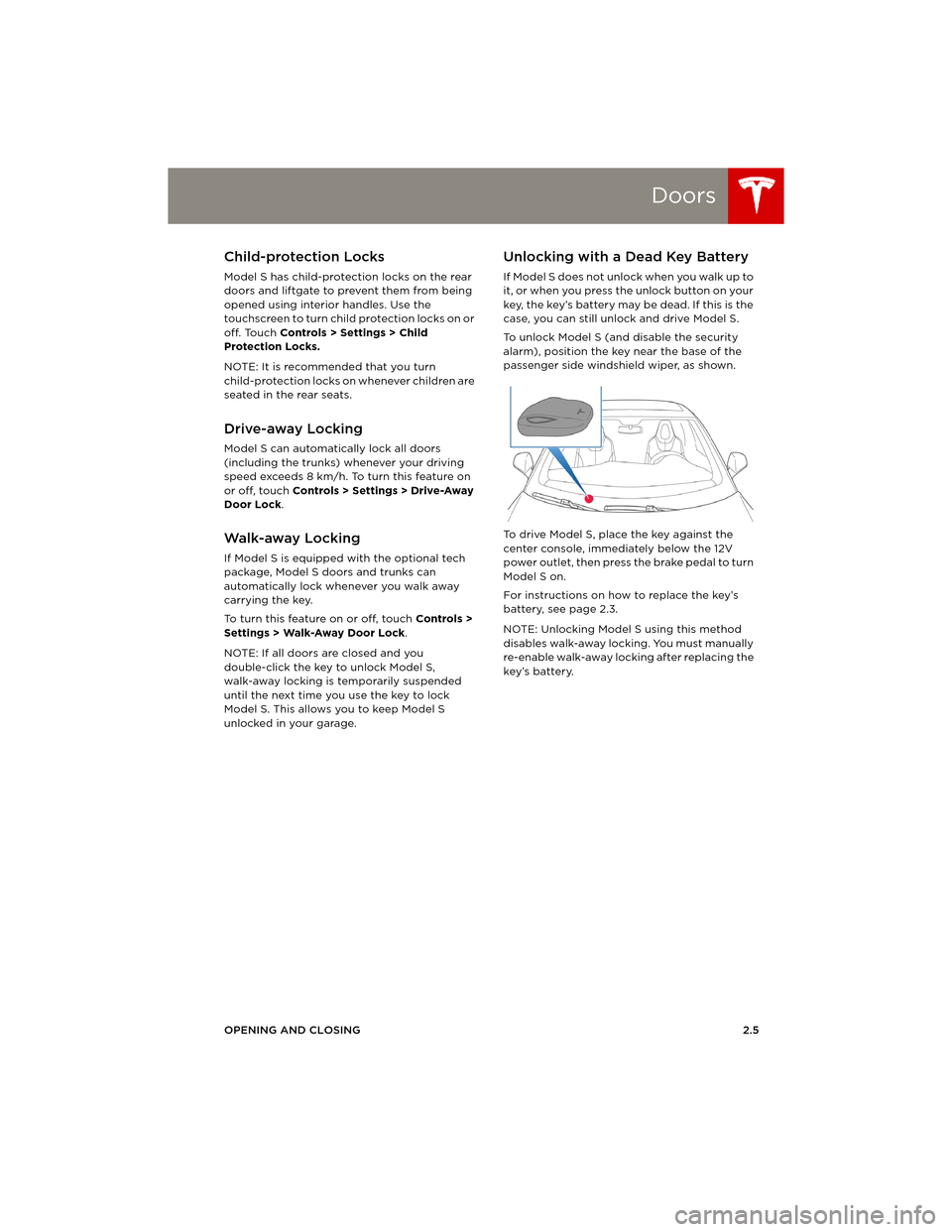
Doors
OPENING AND CLOSING2.5
Child-protection Locks
Model S has child-protection locks on the rear
doors and liftgate to prevent them from being
opened using interior handles. Use the
touchscreen to turn child protection locks on or
off. Touch Controls > Settings > Child
Protection Locks.
NOTE: It is recommended that you turn
child-protection locks on whenever children are
seated in the rear seats.
Drive-away Locking
Model S can automatically lock all doors
(including the trunks) whenever your driving
speed exceeds 8 km/h. To turn this feature on
or off, touch Controls > Settings > Drive-Away
Door Lock.
Walk-away Locking
If Model S is equipped with the optional tech
package, Model S doors and trunks can
automatically lock whenever you walk away
carrying the key.
To turn this feature on or off, touch Controls >
Settings > Walk-Away Door Lock.
NOTE: If all doors are closed and you
double-click the key to unlock Model S,
walk-away locking is temporarily suspended
until the next time you use the key to lock
Model S. This allows you to keep Model S
unlocked in your garage.
Unlocking with a Dead Key Battery
If Model S does not unlock when you walk up to
it, or when you press the unlock button on your
key, the key’s battery may be dead. If this is the
case, you can still unlock and drive Model S.
To unlock Model S (and disable the security
alarm), position the key near the base of the
passenger side windshield wiper, as shown.
To drive Model S, place the key against the
center console, immediately below the 12V
power outlet, then press the brake pedal to turn
Model S on.
For instructions on how to replace the key’s
battery, see page 2.3.
NOTE: Unlocking Model S using this method
disables walk-away locking. You must manually
re-enable walk-away locking after replacing the
key’s battery.
book.book Page 5 Friday, July 19, 2013 12:53 PM
Page 14 of 152

DoorsDoors
2.6MODEL S OWNERS MANUAL
Opening Interior Doors with No
Power
If Model S has no electrical power, front doors
open as usual using the interior door handles.
To open the rear doors, fold back the edge of
the carpet below the rear seats to expose the
mechanical release cable. Pull the mechanical
release cable toward the center.
book.book Page 6 Friday, July 19, 2013 12:53 PM
Page 15 of 152
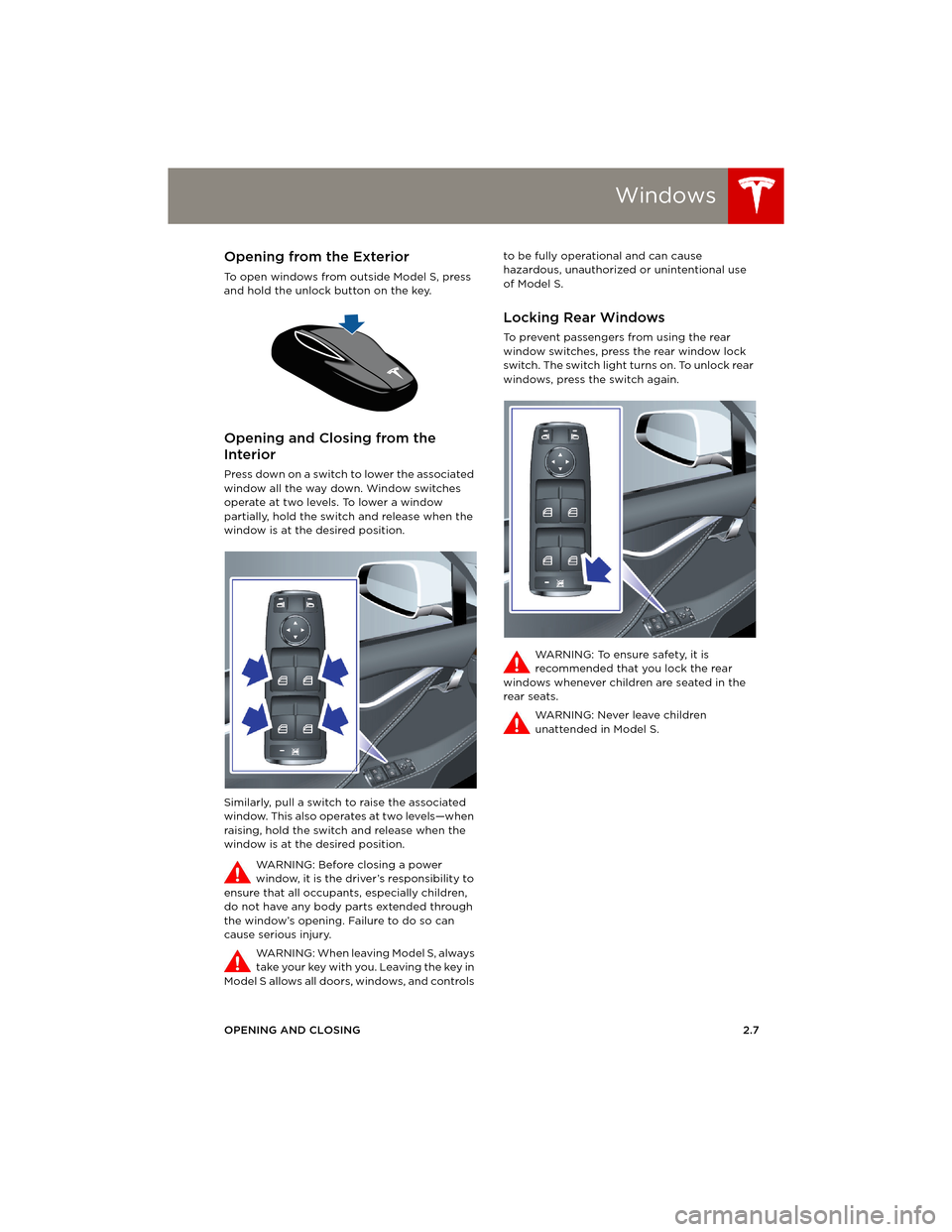
Windows
OPENING AND CLOSING2.7
Wi ndow sOpening from the Exterior
To open windows from outside Model S, press
and hold the unlock button on the key.
Opening and Closing from the
Interior
Press down on a switch to lower the associated
window all the way down. Window switches
operate at two levels. To lower a window
partially, hold the switch and release when the
window is at the desired position.
Similarly, pull a switch to raise the associated
window. This also operates at two levels—when
raising, hold the switch and release when the
window is at the desired position.
WARNING: Before closing a power
window, it is the driver’s responsibility to
ensure that all occupants, especially children,
do not have any body parts extended through
the window’s opening. Failure to do so can
cause serious injury.
WARNING: When leaving Model S, always
take your key with you. Leaving the key in
Model S allows all doors, windows, and controls to be fully operational and can cause
hazardous, unauthorized or unintentional use
of Model S.
Locking Rear Windows
To prevent passengers from using the rear
window switches, press the rear window lock
switch. The switch light turns on. To unlock rear
windows, press the switch again.
WARNING: To ensure safety, it is
recommended that you lock the rear
windows whenever children are seated in the
rear seats.
WARNING: Never leave children
unattended in Model S.
book.book Page 7 Friday, July 19, 2013 12:53 PM
Page 23 of 152
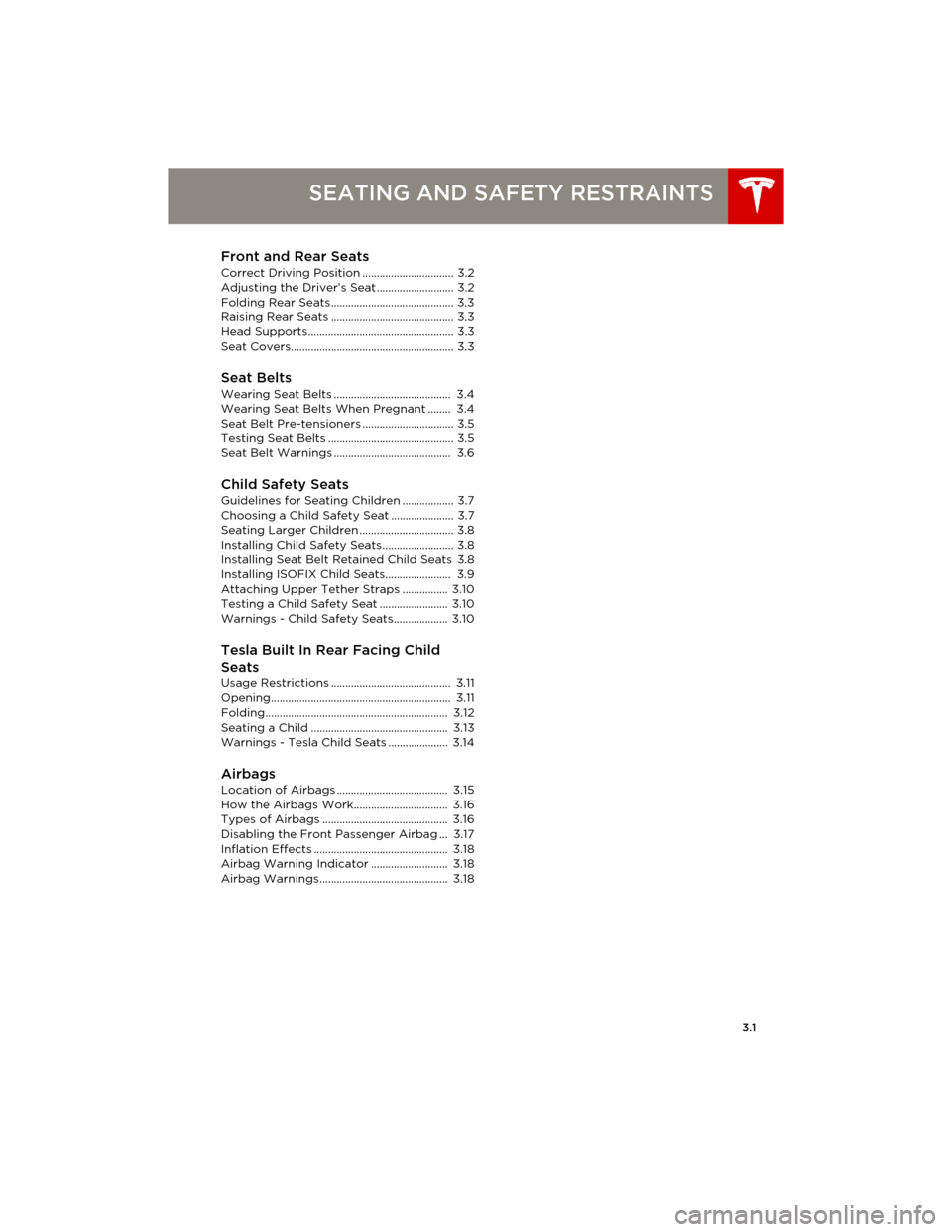
3.1
SEATING AND SAFETY RESTRAINTS
Front and Rear Seats
Correct Driving Position ................................ 3.2
Adjusting the Driver’s Seat ........................... 3.2
Folding Rear Seats........................................... 3.3
Raising Rear Seats ........................................... 3.3
Head Supports................................................... 3.3
Seat Covers......................................................... 3.3
Seat Belts
Wearing Seat Belts ......................................... 3.4
Wearing Seat Belts When Pregnant ........ 3.4
Seat Belt Pre-tensioners ................................ 3.5
Testing Seat Belts ............................................ 3.5
Seat Belt Warnings ......................................... 3.6
Child Safety SeatsGuidelines for Seating Children .................. 3.7
Choosing a Child Safety Seat ...................... 3.7
Seating Larger Children ................................. 3.8
Installing Child Safety Seats......................... 3.8
Installing Seat Belt Retained Child Seats 3.8
Installing ISOFIX Child Seats....................... 3.9
Attaching Upper Tether Straps ................ 3.10
Testing a Child Safety Seat ........................ 3.10
Warnings - Child Safety Seats................... 3.10
Tesla Built In Rear Facing Child
Seats
Usage Restrictions .......................................... 3.11
Opening............................................................... 3.11
Folding................................................................ 3.12
Seating a Child ................................................ 3.13
Warnings - Tesla Child Seats ..................... 3.14
Airbags
Location of Airbags ....................................... 3.15
How the Airbags Work................................. 3.16
Types of Airbags ............................................ 3.16
Disabling the Front Passenger Airbag ... 3.17
Inflation Effects ............................................... 3.18
Airbag Warning Indicator ........................... 3.18
Airbag Warnings............................................. 3.18
book.book Page 1 Friday, July 19, 2013 12:53 PM
Page 24 of 152
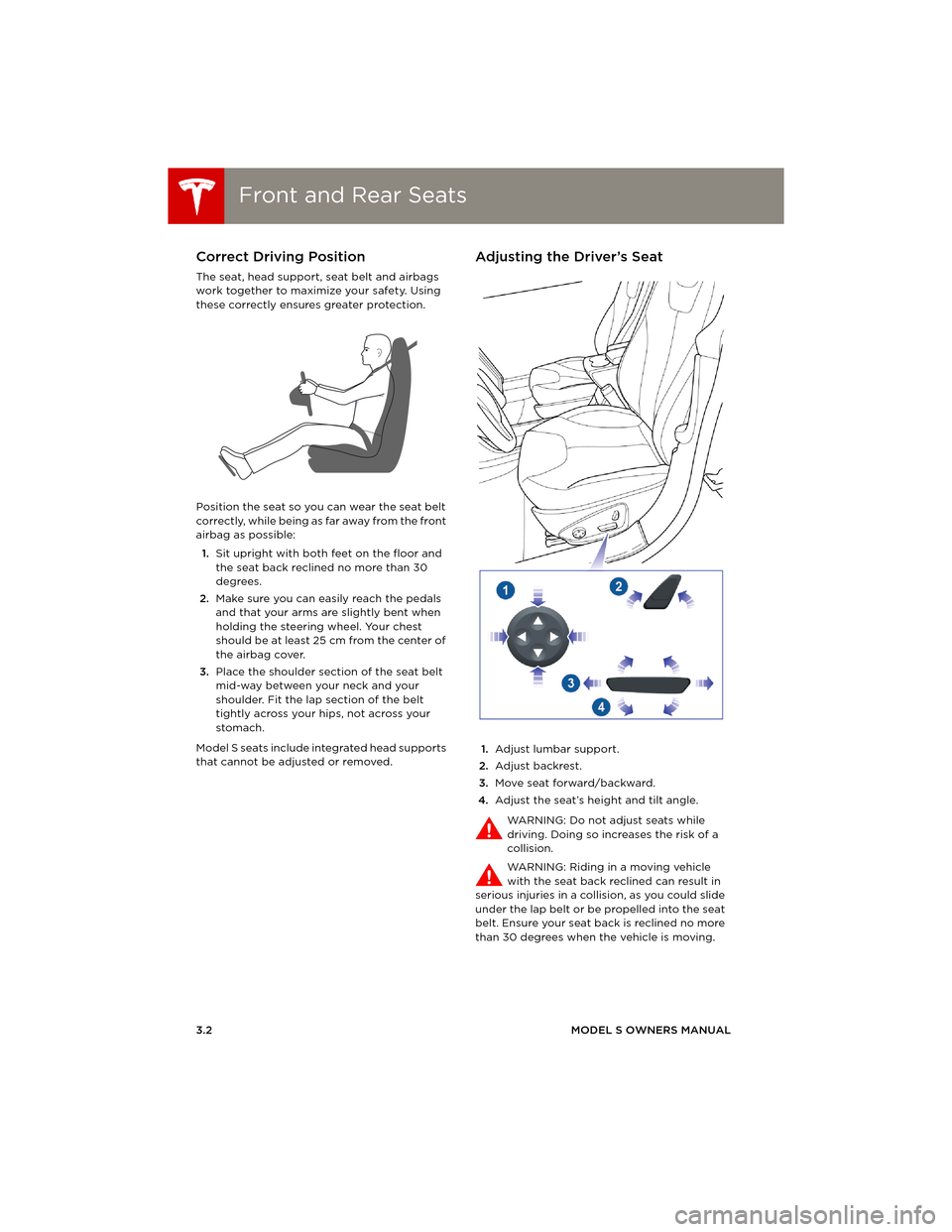
Front and Rear SeatsFront and Rear Seats
3.2MODEL S OWNERS MANUAL
SEATING AND SAFETY RESTRAINTS
Front and Rear SeatsCorrect Driving Position
The seat, head support, seat belt and airbags
work together to maximize your safety. Using
these correctly ensures greater protection.
Position the seat so you can wear the seat belt
correctly, while being as far away from the front
airbag as possible:
1.Sit upright with both feet on the floor and
the seat back reclined no more than 30
degrees.
2.Make sure you can easily reach the pedals
and that your arms are slightly bent when
holding the steering wheel. Your chest
should be at least 25 cm from the center of
the airbag cover.
3.Place the shoulder section of the seat belt
mid-way between your neck and your
shoulder. Fit the lap section of the belt
tightly across your hips, not across your
stomach.
Model S seats include integrated head supports
that cannot be adjusted or removed.
Adjusting the Driver’s Seat
1.Adjust lumbar support.
2.Adjust backrest.
3.Move seat forward/backward.
4.Adjust the seat’s height and tilt angle.
WARNING: Do not adjust seats while
driving. Doing so increases the risk of a
collision.
WARNING: Riding in a moving vehicle
with the seat back reclined can result in
serious injuries in a collision, as you could slide
under the lap belt or be propelled into the seat
belt. Ensure your seat back is reclined no more
than 30 degrees when the vehicle is moving.
book.book Page 2 Friday, July 19, 2013 12:53 PM
Page 25 of 152
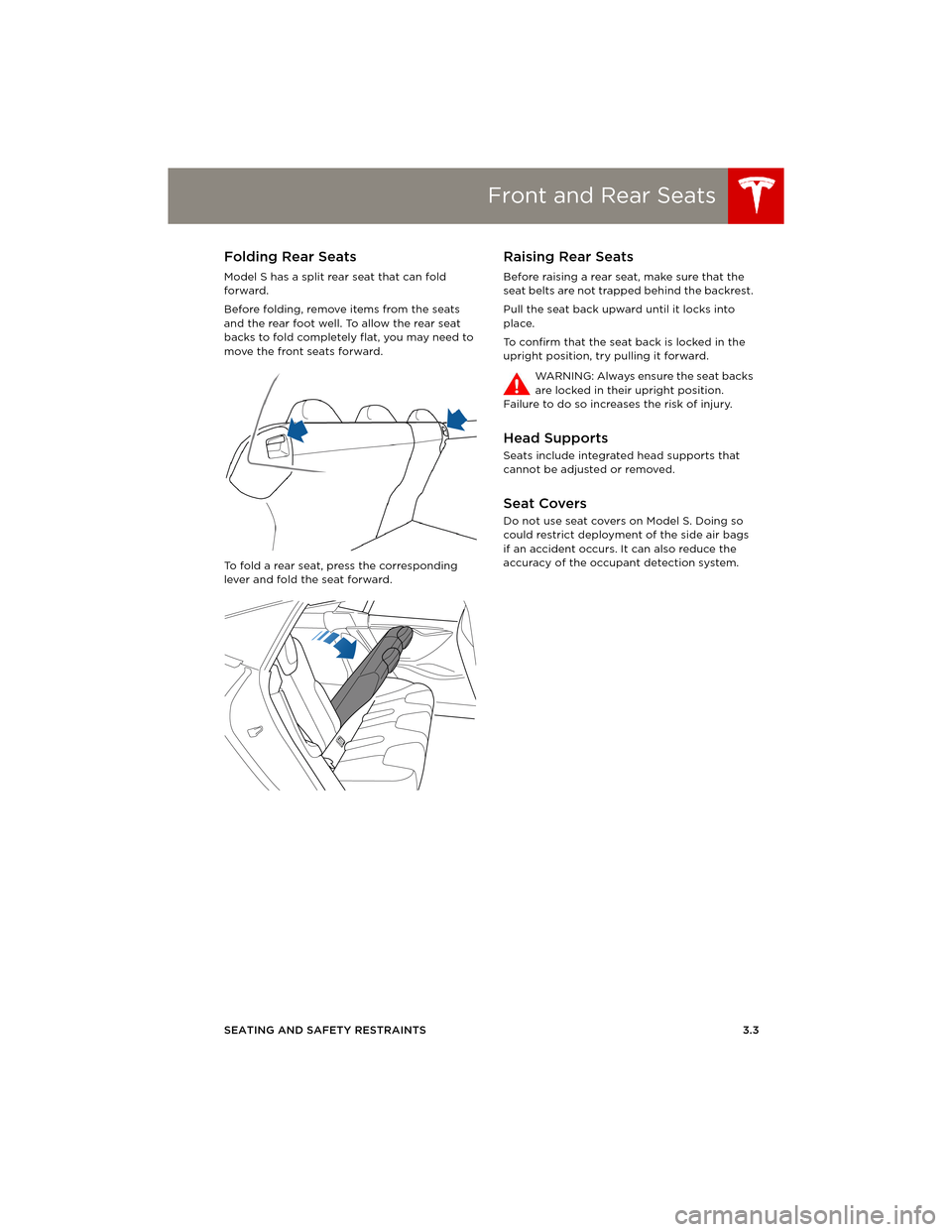
Front and Rear Seats
SEATING AND SAFETY RESTRAINTS 3.3
Folding Rear Seats
Model S has a split rear seat that can fold
forward.
Before folding, remove items from the seats
and the rear foot well. To allow the rear seat
backs to fold completely flat, you may need to
move the front seats forward.
To fold a rear seat, press the corresponding
lever and fold the seat forward.
Raising Rear Seats
Before raising a rear seat, make sure that the
seat belts are not trapped behind the backrest.
Pull the seat back upward until it locks into
place.
To confirm that the seat back is locked in the
upright position, try pulling it forward.
WARNING: Always ensure the seat backs
are locked in their upright position.
Failure to do so increases the risk of injury.
Head Supports
Seats include integrated head supports that
cannot be adjusted or removed.
Seat Covers
Do not use seat covers on Model S. Doing so
could restrict deployment of the side air bags
if an accident occurs. It can also reduce the
accuracy of the occupant detection system.
book.book Page 3 Friday, July 19, 2013 12:53 PM
Page 26 of 152
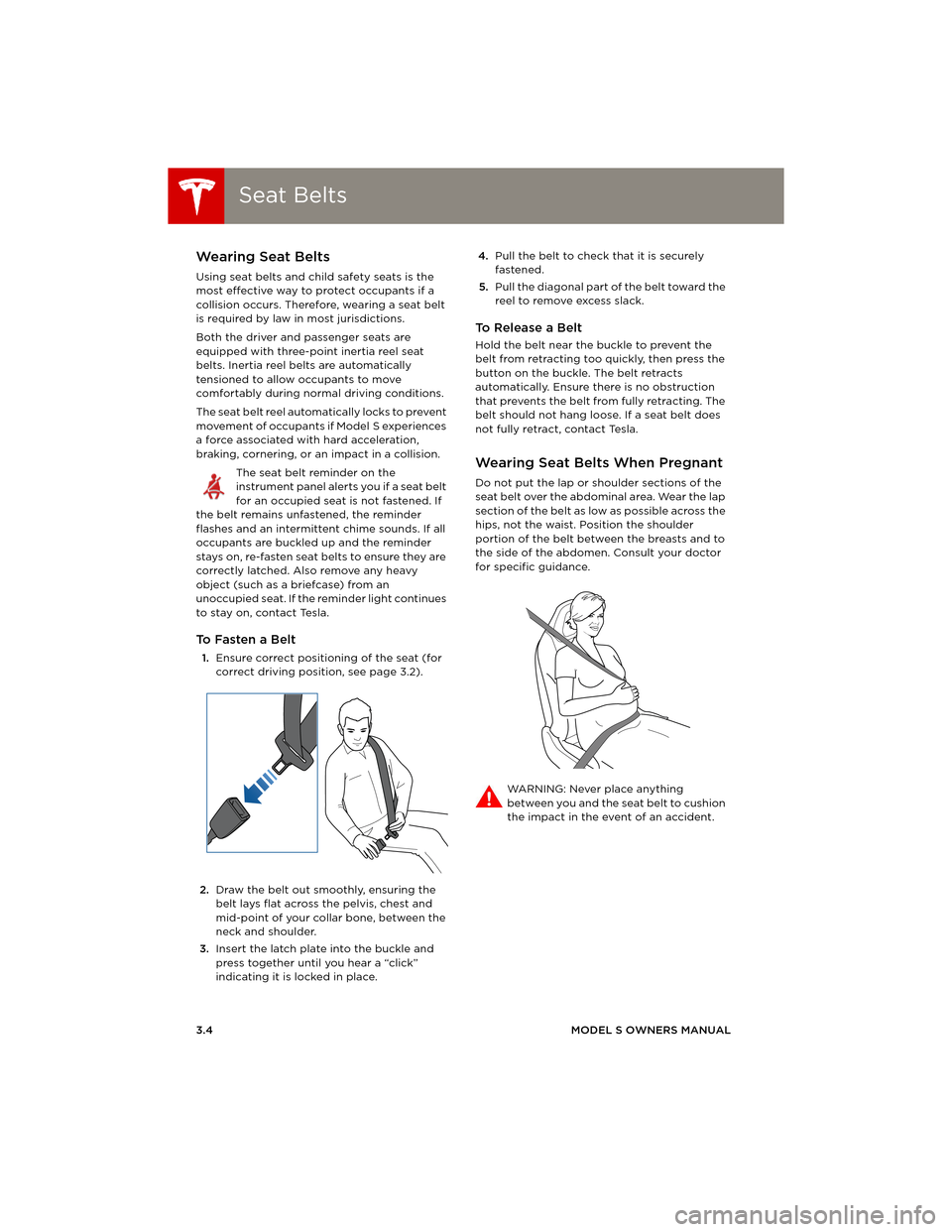
Seat BeltsSeat Belts
3.4MODEL S OWNERS MANUAL
Seat BeltsWearing Seat Belts
Using seat belts and child safety seats is the
most effective way to protect occupants if a
collision occurs. Therefore, wearing a seat belt
is required by law in most jurisdictions.
Both the driver and passenger seats are
equipped with three-point inertia reel seat
belts. Inertia reel belts are automatically
tensioned to allow occupants to move
comfortably during normal driving conditions.
The seat belt reel automatically locks to prevent
movement of occupants if Model S experiences
a force associated with hard acceleration,
braking, cornering, or an impact in a collision.
The seat belt reminder on the
instrument panel alerts you if a seat belt
for an occupied seat is not fastened. If
the belt remains unfastened, the reminder
flashes and an intermittent chime sounds. If all
occupants are buckled up and the reminder
stays on, re-fasten seat belts to ensure they are
correctly latched. Also remove any heavy
object (such as a briefcase) from an
unoccupied seat. If the reminder light continues
to stay on, contact Tesla.
To F a s t e n a B e l t
1.Ensure correct positioning of the seat (for
correct driving position, see page 3.2).
2.Draw the belt out smoothly, ensuring the
belt lays flat across the pelvis, chest and
mid-point of your collar bone, between the
neck and shoulder.
3.Insert the latch plate into the buckle and
press together until you hear a “click”
indicating it is locked in place.4.Pull the belt to check that it is securely
fastened.
5.Pull the diagonal part of the belt toward the
reel to remove excess slack.
To Release a Belt
Hold the belt near the buckle to prevent the
belt from retracting too quickly, then press the
button on the buckle. The belt retracts
automatically. Ensure there is no obstruction
that prevents the belt from fully retracting. The
belt should not hang loose. If a seat belt does
not fully retract, contact Tesla.
Wearing Seat Belts When Pregnant
Do not put the lap or shoulder sections of the
seat belt over the abdominal area. Wear the lap
section of the belt as low as possible across the
hips, not the waist. Position the shoulder
portion of the belt between the breasts and to
the side of the abdomen. Consult your doctor
for specific guidance.
WARNING: Never place anything
between you and the seat belt to cushion
the impact in the event of an accident.
book.book Page 4 Friday, July 19, 2013 12:53 PM
Page 29 of 152
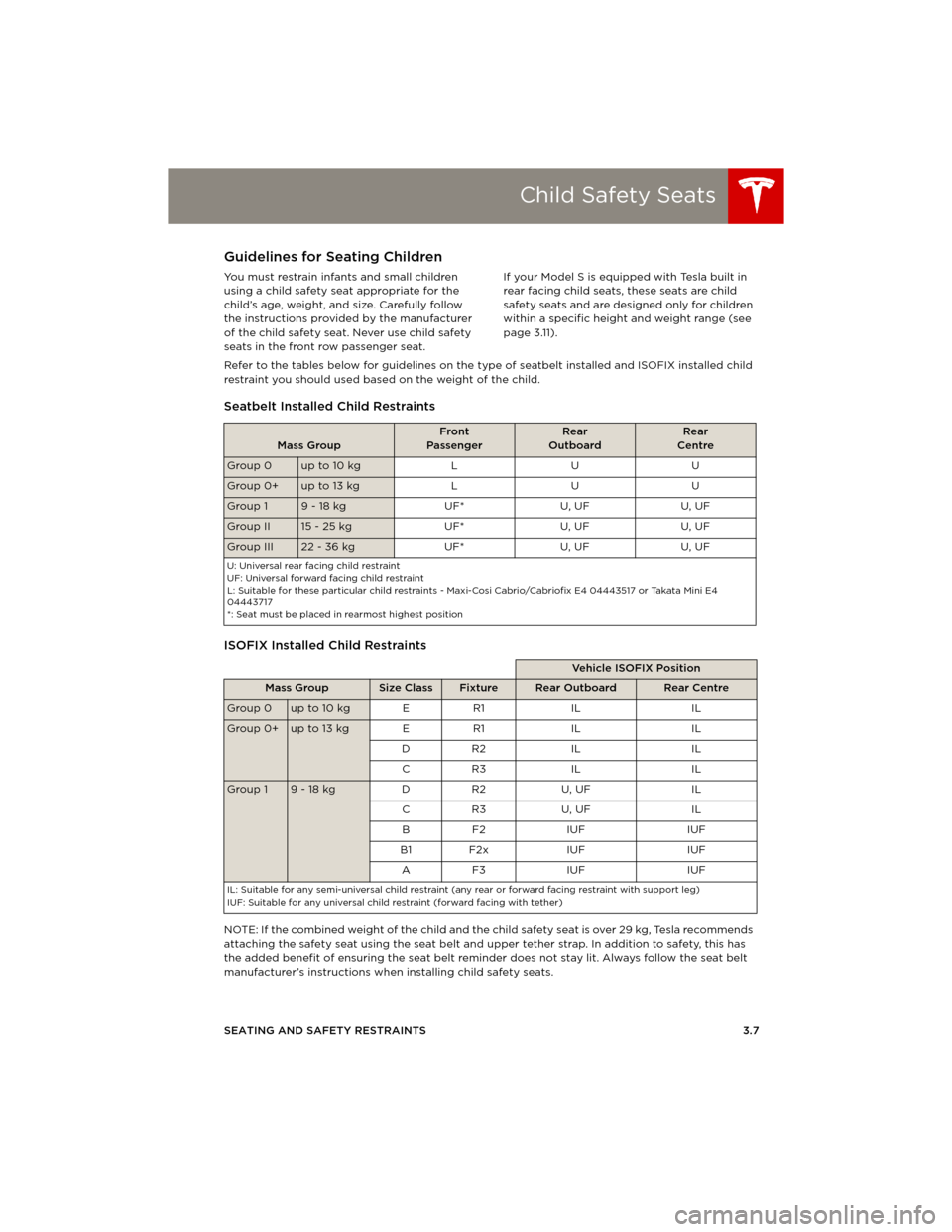
Child Safety Seats
SEATING AND SAFETY RESTRAINTS 3.7
Child Safety SeatsGuidelines for Seating Children
You must restrain infants and small children
using a child safety seat appropriate for the
child’s age, weight, and size. Carefully follow
the instructions provided by the manufacturer
of the child safety seat. Never use child safety
seats in the front row passenger seat. If your Model S is equipped with Tesla built in
rear facing child seats, these seats are child
safety seats and are designed only for children
within a specific height and weight range (see
page 3.11).
Refer to the tables below for guidelines on the type of seatbelt installed and ISOFIX installed child
restraint you should used based on the weight of the child.
Seatbelt Installed Child Restraints
ISOFIX Installed Child Restraints
NOTE: If the combined weight of the child and the child safety seat is over 29 kg, Tesla recommends
attaching the safety seat using the seat belt and upper tether strap. In addition to safety, this has
the added benefit of ensuring the seat belt reminder does not stay lit. Always follow the seat belt
manufacturer’s instructions when installing child safety seats.
Mass GroupFront
PassengerRear
OutboardRear
Centre
Group 0up to 10 kg L U U
Group 0+up to 13 kg L U U
Group 19 - 18 kg UF* U, UF U, UF
Group II15 - 25 kg UF* U, UF U, UF
Group III 22 - 36 kg UF* U, UF U, UF
U: Universal rear facing child restraint
UF: Universal forward facing child restraint
L: Suitable for these particular child restraints - Maxi-Cosi Cabrio/Cabriofix E4 04443517 or Takata Mini E4
04443717
*: Seat must be placed in rearmost highest position
Vehicle ISOFIX Position
Mass GroupSize ClassFixtureRear OutboardRear Centre
Group 0up to 10 kg E R1 IL IL
Group 0+up to 13 kg E R1 IL IL
DR2 IL IL
CR3 IL IL
Group 19 - 18 kg D R2 U, UF IL
CR3 U, UF IL
BF2 IUF IUF
B1 F2x IUF IUF
AF3 IUF IUF
IL: Suitable for any semi-universal child restraint (any rear or forward facing restraint with support leg)
IUF: Suitable for any universal child restraint (forward facing with tether)
book.book Page 7 Friday, July 19, 2013 12:53 PM